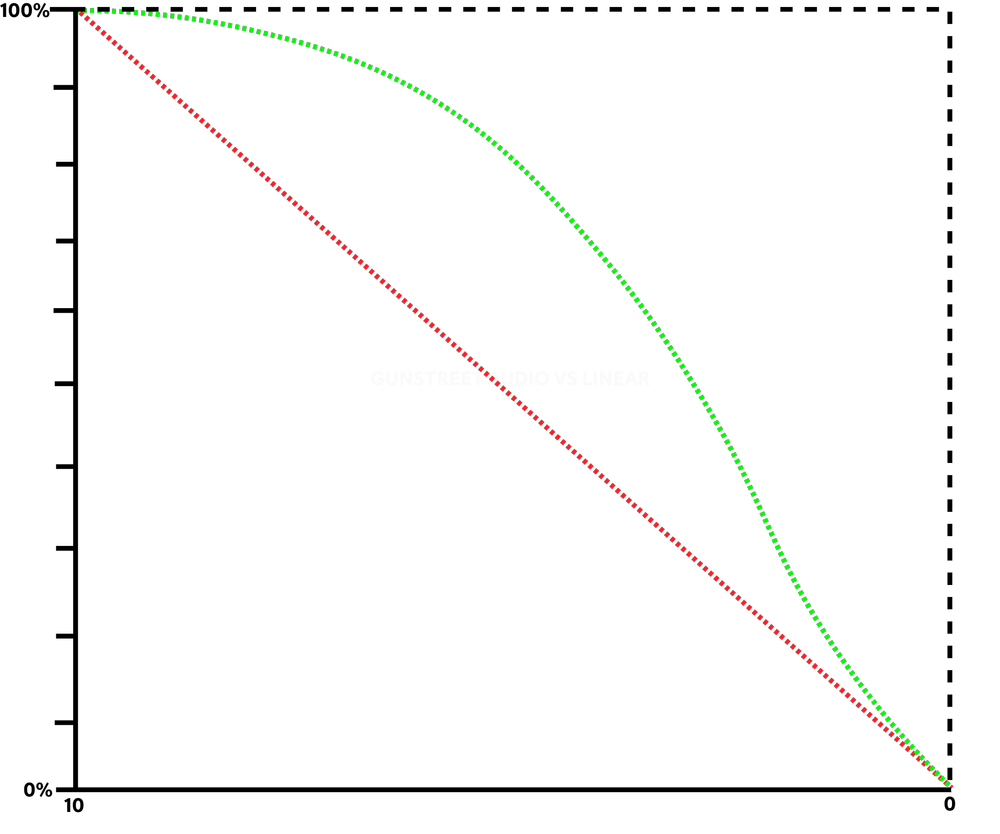Whats the difference between Linear vs Audio Pots?
or more realistically Why your Audible taper has little to do with them.
BY SEAN ARBOW
So, when I first sat down to write this post, I thought about doing it the normal way and talking about how wrong gatekeeping in the wiring world is to you the end user. But, as I dug deeper and looked back at my own work history, aka the tens of thousands of customers i have worked with. I noticed overall that there are very few times people have been offended by us choosing one style over another. In fact, I was more surprised by people blaming even high-end wiring as “poor quality” not knowing this subtle difference could be the one main reason why they might hate it. So, in this post I am going to really stay away from taking a side and talk more about how you the end user should think about it, when you want to correct something you don’t like about your wiring.
First, we should really define what all the key ideas mean on a macro level, so when you start to read this, you can have a general idea of what we are talking about.
-
Pot Manufactures Tapers
Audio: The ideal of Audio taper potentiometers is easy, to have a “sweep” or taper that decreases in a mathematical way that matches how the Human Ear hears.
Linear: With Linear the Taper is designed to decrease in a consistent rate. Using a Voltage divider (volume) as a reference. At 10 the pickups output is 100%, Decreasing to 9 means the pickups output is at 90%, and 8 is 80%, and so on.
Audible Taper: This is an abstract idea. Basically, has nothing to do with the manufactures taper and just means how you personally hear how the wiring sounds as you decrease the volume or tone.
Brands have preferences: Depending on what brand you get there is a “brand sound” they are trying to achieve. So every brand will have their own combo when it comes to what they use in either the Volume or Tone. Examples are Brand A. is Linear in the volume and Audio in the tone. Brand B. is Audio in the volume, and Linear in the tone, Brand C. is Linear for everything, Brand D. is Audio for everything. Realistically there are no wrong choices just a designer’s opinion to achieve a sound.
What defines an Audible Taper?
So, there is a ton of variables that will make up how your instruments audible taper will work in the end. Luckily, there is some science to it. Here’s a sure-fire way to confuse a lot of people and make it sound fancy…. a made-up math formula.
(PEQ+FC) + (PMT+PP)= AT

Let’s break down this and explain what we are actually talking about.
-
(PEQ+FC)
PEQ aka Pickup EQ: Since all the wiring is doing is filtering the output signal of the pickups, you want to figure what that EQ range is. Are your pickups a high or low-end focused sound?
-
FC or Filter Circuit: You want to think about this part in 2 different ways.
What style of filter circuit do I want? Your options are either a High or Low pass filter. Aka either you save more high- or low-end frequencies as you decrease the volume.
How will the individual circuit architecture effect the audible taper. Basically, depending on how the voltage divider and RC filter are wired and the values you choose, will change how the volume(s) or tone(s) will react.
Now the really abstract one. (PMT+PP)
PMT aka Pot Manufactures Taper: This again has to do with your choice of audio vs linear. When you pair this with the PEQ+FC portion, you can “fix” some of the perceived negative quirks you get with your choices.
-
PP- Personal Preferences: This is huge. I can’t tell you how many times i have either offended someone by not using their personal favorite manufactures taper, or b. have heard the terms “i hate this, this volume has a steep taper” no matter what PMT is used. What I mean by that is whatever instrument/brand you learned to use your controls on, or had gotten used to, will cause you to have a preference to how the PMT reacts with the other variables. Example being.
Person A. will say “This volume has a steep taper” when they prefer a linear volume or tone and bought an Audio setup.
Person B. will say “This volume has a steep taper” when they prefer Audio but got a linear taper.
See what I mean, same exact complaint but 2 different preferences. I never realized until doing this job at the scale we are at just how important the customers personal preferences are. Seriously, this subtle tweak in your circuit has been a huge undervalued/overlooked thing in the community for years. The inside joke is you can make a case that those goober companies who sell magic “upgrades” get statistically lucky, because even though in most cases they are selling you a part for part circuit copy of your guitars stock wiring using buzz words. Depending on what style they used in comparison to your preference will cause you to believe those magic parts made it a good wiring harness, despite good parts meaning durability.
Add all the variables together you will get your desired Audible Taper!
Now If I have lost you at this point, I’ll try to simplify it more. Listening to the instrument while using the controls
-
Do you like how the pickups sound overall, but hate the Audible Taper? Or does the taper sound fine, but the eq is bad or wrong?
If you hate the EQ: keep everything about the wiring (aka whatever the PMT’s are) and change the Filter circuit.
If you like the sound but hate the Audible Taper: Then try a different PMT in either position but keep the Filter circuit
If you hate both: Change the Filter circuit and PMT
Now since I have been getting a ton of fans who are Techs at local stores wanting tips. (Which is really cool BTW. Just don’t forget about me when you get famous! 😉) Let’s talk about some “Vanilla” or “Safe Choices” you can suggest to your customers from my own experiences.
When I started making kits almost 2 decades ago, I would just do whatever the manufactures set it as. Often that would be Linear in the Volume(s) and Audio in the Tone(s). Way too many people hated that, so i changed it to another popular combo, Audio in the Volume(s) and Linear in the tone(s). Less people complained about the volume(s) but a small amount of people hated the tone(s), finally I said “fine let’s simplify this” and used Audio for everything. All the sudden I got fewer and fewer complaints. So, if you want a safe choice go with Audio, that tends to be the most natural sounding overall to people who don’t like their sound.
About the Author: Sean Arbow
Sean has been obsessed with circuit designing for 17+ years, He is our custom shop builder and has made tens of thousands of kits for people, including some very high-profile musicians. He's the style of nerd your favorite local tech fanboys about
